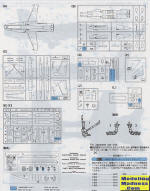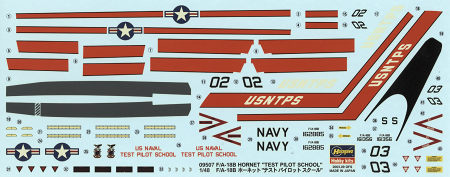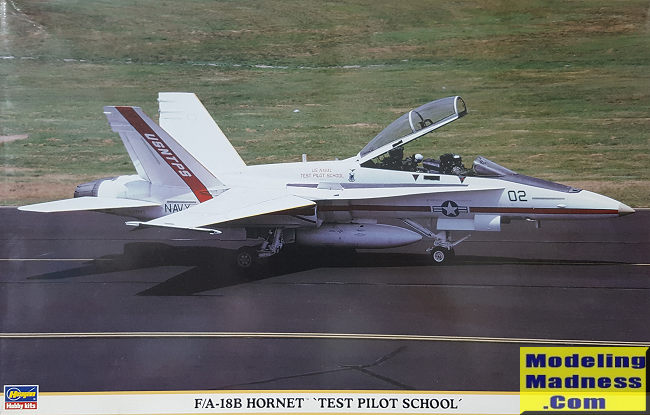One thing that most nations realized fairly early in the jet age was that
these increasingly sophisticated aircraft needed a dedicated trainer. In the
past, generic trainers were utilized before the pilot moved on to whatever
type they would be flying. It was all well and good to learn jets on a T-33,
but sometimes transitioning into a more demanding type (like a Demon, or
Cutlass, or Crusader resulted in crashes or fatalities that might have been
prevented had a dedicated two seat trainer been available. To be sure in
some cases (like the Crusader) one was developed, but was not put into
service.
By the time of the F-18, there were training versions of whatever was in the
fleet in terms of tactical jets. Since previous 60s and 70s era jets were
two seaters anyway, having a few set aside to train pilots was not a major
issue. With the introduction of the Hornet, a dedicated training version was
developed and these aircraft were included in every foreign sales as well.
Eventually the two seater was used in a tactical role by the USMC, but that
is a different story.
 Hasegawa
was fairly early in providing a twin seat F-18 with the single seat F-18A
released in 1991 and a two seat F-18D in 1993. The external difference
between the F-18B and D is minimal with the biggest being the vertical
stabilizers.
Hasegawa
was fairly early in providing a twin seat F-18 with the single seat F-18A
released in 1991 and a two seat F-18D in 1993. The external difference
between the F-18B and D is minimal with the biggest being the vertical
stabilizers.
The kit has a nice interior that doesn't use decals for the
instrument panels. In fact, there are a few p.e. inserts that need to be
applied. The five piece ejection seats are fairly good and you get crew members
to cover up the lack of seat belts.
One has to open holes for the various pylons both in the lower wing
pieces and the lower fuselage. Part of the upper wing is molded with the upper
fuselage so this helps in alignment. Keep in mind that these trainers rarely
carried weapons pylons or weapons as they simply were not normally needed. Since
the flights were fairly short, either no fuel tanks or just a centerline was
used. The aircraft has a boarding ladder than can be posed lowered if one
so wishes.
Probably the most difficult part of any scale Hasegawa F-18 is the
intakes and rear fuselage sections. One does need to take care and test fit
often to ensure minimal filler work. The kit provides the option to have the
flaps and slats lowered and as most Hornets had at least the flaps down while on
the ground, this is a welcome move. Again, one has to be quite careful when
doing this section as it is easy to get things out of alignment.
Landing gear and doors are well done and quite hefty with the doors
including retraction hinges. Reinforcements for the tailplanes are provided as
separate items. The kit provides the A model tailplanes so you cannot do an
F-18D with what comes in the box. Both the canopy and speed brake can be posed
open, though rarely did one see the brake open while on the ground.
 Hasegawa
provides you with the instructions for the F-18D and a small addendum sheet for
the B. Note that there are antennas on the D that are not used on the B so one
really does have to be careful during construction not to add these superfluous
items. There is a single markings option and that is the box art plane with the
USN Test Pilot School. The aircraft is overall white and the decals provide all
the color you need for this one.
Hasegawa
provides you with the instructions for the F-18D and a small addendum sheet for
the B. Note that there are antennas on the D that are not used on the B so one
really does have to be careful during construction not to add these superfluous
items. There is a single markings option and that is the box art plane with the
USN Test Pilot School. The aircraft is overall white and the decals provide all
the color you need for this one.


 Hasegawa
was fairly early in providing a twin seat F-18 with the single seat F-18A
released in 1991 and a two seat F-18D in 1993. The external difference
between the F-18B and D is minimal with the biggest being the vertical
stabilizers.
Hasegawa
was fairly early in providing a twin seat F-18 with the single seat F-18A
released in 1991 and a two seat F-18D in 1993. The external difference
between the F-18B and D is minimal with the biggest being the vertical
stabilizers.  Hasegawa
provides you with the instructions for the F-18D and a small addendum sheet for
the B. Note that there are antennas on the D that are not used on the B so one
really does have to be careful during construction not to add these superfluous
items. There is a single markings option and that is the box art plane with the
USN Test Pilot School. The aircraft is overall white and the decals provide all
the color you need for this one.
Hasegawa
provides you with the instructions for the F-18D and a small addendum sheet for
the B. Note that there are antennas on the D that are not used on the B so one
really does have to be careful during construction not to add these superfluous
items. There is a single markings option and that is the box art plane with the
USN Test Pilot School. The aircraft is overall white and the decals provide all
the color you need for this one.